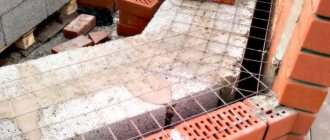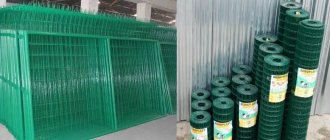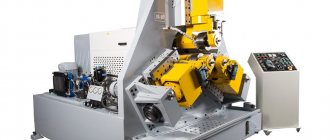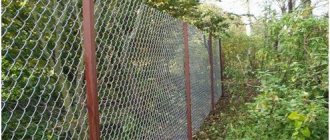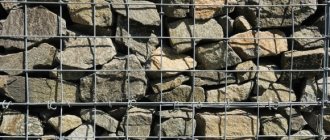Whatever the situation in the next 2-3 decades in the real estate sector, we can already safely say that the demand for existing building materials (at least in our country) will remain consistently high. This means that this direction is very promising and tempting for those who are now in search of a suitable business project. Such business ideas include the production of chain-link mesh.
Brief business analysis: Costs of organizing a business: 50 – 400 thousand rubles Relevant for cities with a population: from 50 thousand people Situation in the industry: high competition Difficulty of organizing a business: 2/5 Payback: 6 – 8 months
All readers are well aware of what a chain-link mesh is. Durable, long-lasting, aesthetically pleasing fencing has gained enormous popularity since its appearance on the building materials market.
However, soon the functionality of the chain-link mesh expanded significantly, and they began to use it not only to make fences for personal plots of land, but also to build pens for livestock and poultry, enclosures for wild animals in zoos, and using a fine-mesh mesh to sift through bulk construction materials. materials - sand, sand-gravel mixture, etc., use chain-link for reinforcement during plastering work, strengthen the slopes of embankments from sliding - this is only a small part of the work in which chain-link mesh is used.
Material for making chain-link
Chain-link mesh is made of wire. It could be:
- low carbon steel wire;
- galvanized wire (products in greatest demand);
- polymer-coated wire;
- stainless steel wire (such things are usually made to order).
All necessary raw materials are always available at any metal rolling base. By concluding a contract for regular purchases, you can obtain a significant discount on goods from raw material suppliers. At the time of writing, the price of one ton of galvanized wire for making chain-link in the country’s markets ranged from 28 to 35 thousand rubles, depending on the region.
Analysis of demand in the region
Any business requires preliminary preparation, which also includes assessing the demand for future products in a particular region. In addition to taking into account the volume of construction work carried out in your area that requires the large-scale use of chain-link mesh, the level of private construction, the number of farmers who make up a very significant share of consumers of these products, it is necessary to take into account the presence of competitors and the volume of mesh they produce.
The best option is to “test the waters” and conclude (you can even do it on an oral basis) contracts for the supply of your future product. Having such guarantees for the sale of your product, you can safely begin implementing the project. It will take a maximum of 2-3 days to organize a small mini-factory. This is quite enough to install the equipment and train hired personnel to operate the mesh weaving machine.
Determining the price of a product depends on the following factors:
- the size of the mesh cells (the smaller the mesh, the more wire is used to make the mesh, and, accordingly, the higher its cost should be);
- type of wire used in the mesh – galvanized, polymer-coated, black, stainless steel;
- wire diameter (the most common standards are from 1.5 to 5.5 mm. The diameter step is usually added by 0.5 mm. But there are also non-standard sizes, for example, wire with a cross-section of 1.75, 1.85, and etc. Usually, clients who order the production of chain-link mesh from such materials provide the raw materials themselves.
conclusions
Having established the process and regularly making a profit, you can then think about expanding production capacity. This could be the purchase of metal-cutting machines or expanding the range of wire products. For example, equipment for the production of masonry mesh using the welding method can expand the range of buyers.
Fulfilling corporate requirements is of great importance. Standards have been defined for all types of products, and when purchasing, the customer is guided by the usual values for wire cross-section, mesh size, and mesh width.
The share of products that differ in characteristics from conventional products is small. These are mainly special cases that are agreed upon by the client in advance.
Average rating for this type of business:
- Starting capital investment – from 1 million rubles.
- Market saturation is average.
- Problematicity of opening – 7/10.
With a responsible approach, the production of metal mesh is profitable. Profitability can reach up to 30%, which is considered a very good indicator, which can be problematic to achieve in other areas. The work cycle is short, the number of operations and types of raw materials are small.
Equipment for the production of chain-link mesh
All equipment is a machine for the production of chain-link mesh. Among the variety of types and manufacturers of equipment for making chain-link, it is quite difficult to choose the machine that is most suitable for you, especially if you have a very superficial understanding of its operation.
The two main options worthy of attention are factory-made (there are also hand-made assemblies) machines - semi-automatic or automatic.
Semi-automatic machines for weaving mesh netting
The main disadvantage, which is also some advantage of such a machine, is the participation of the operator in its work. The advantages are continuous control over the production process, small dimensions of the machine, simple setup of equipment, and low price - from 20 thousand rubles (used machines) to 50 thousand rubles (new factory ones).
The disadvantages are that some operations have to be performed manually, including bending the mesh, which can lead to disruption of the cell dimensions and the appearance of other small flaws.
Automatic chain linking machines
An ideal option for those who want to produce high quality products and minimize defects. Maintenance of such a machine comes down to loading a spool of wire into the machine and removing the finished roll of mesh.
The advantages of an automatic machine are its greater productivity - up to 100 sq. meters in one hour, compliance with the specified mesh weaving parameters, minimal human participation. There are also disadvantages - the high price of the equipment - from 200 to 350 thousand rubles, the high cost of repairs in case of breakdown, the need to train personnel to operate the machine.
As an example of the equipment of a workshop, we can cite ACP15/2 - a machine on which the chain-link is produced automatically, the package of which includes:
- the machine itself;
- wire unwinding device;
- 2 sets of equipment, consisting of a screw bushing, a winding plate, and a receiving pipe);
- machine passports and documentation on operating rules.
Such a machine costs around 250 thousand rubles (plus or minus 10-20 thousand). The width of the mesh cells produced on such equipment is from 20 to 60 mm, productivity is from 21 to 62 sq. meters of grid per hour (depending on the size of the grid cells).
Additional equipment for the workshop will consist of:
- racks for storing finished mesh;
- reception desk;
- and the operator's workplace.
Of course, you should not limit yourself to one machine if you have the financial opportunity to purchase several and there are product sales channels.
Similar business ideas:
- how to start a nail production
- how to organize the production of self-tapping screws
- production of paving slabs
Best models
The rating of the machines showed that among all the variety, three models especially stand out.
ACP15/2
In first place is the ACP15/2 machine, characterized by simple settings and controls. He produces chain-link mesh in small quantities. Due to the low noise level, any location is suitable for installation, even near residential buildings. Without an operator, the unit is capable of independently bending the ends of the mesh, winding the fabric, cutting and stopping. As for all other processes, they are performed by humans. At the exit from the machine, a mesh with a cell of 18-50 mm and a height of 2-3 meters is obtained. For knitting, wire in one thread is used. Moreover, it may have a polymer coating or be unevenly rigid.
The advantages of the device include a gearmotor as a single unit, as well as an improved cooling system due to an emulsion pump. The guide bushings serve for a very long time and without failures, as they are coated with special hard alloys. If the unit is forced to stop, the program settings that were previously set are not lost.
SPA 01-04
Second place went to a knitting machine called SPA 01-04. This machine creates a mesh with a cell size of 2-6 cm. Conveniently, the starting material is one millimeter thick galvanized wire. The unit works completely independently. The operator only prepares the work template in advance, and also supplies the starting materials and removes the finished materials from the unit.
The device automatically unwinds the wire, weaves a chain-link, bending the ends on each of the cells. At the end of weaving, the finished fabric is rolled into a roll. If the material becomes entangled at one of the stages of the device’s operation, it will stop automatically. Conveniently, the unit is equipped with high-quality cooling to avoid overheating. In an hour the device is capable of producing 65-180 sq. meters of chain-link. If desired, the machine can be supplemented with special devices that allow you to wind the mesh on a separate reel. It is convenient that the unit can bend the ends of the chain-link on both sides.
VSA-97
The top best machines for weaving chain-link also included the VSA-97 model. Using this device, you can obtain a web with a cell of 10-60 mm and a width of 50-200 cm. Among the advantages of the unit, users note the universal design of the pass elements, which allows the use of any wire. The machine can be repaired using simple automotive parts. You can find the latter in any specialized store, which can be found even in small towns.
To install the machine you will need approximately 20 square meters of area. One operator will be able to work simultaneously with three such devices. Productivity is directly affected by the quality of the wire. For example, with stable feedstock, the machine can produce 50 square meters per hour. m of canvas with a cell of 50 mm. Many people also like that the device is easy to set up and performs all functions automatically.
Chain-link mesh manufacturing technology
The operating principle of ACP15/2 is simple and consists of several steps. Almost anyone can master:
- load the wire spool into the machine;
- set the microprocessor certain parameters of the future chain-link – wire cross-section, mesh cell diameter, roll dimensions, and press the “start” button;
Then the work of the machine itself begins:
- the unwinding device pulls the wire out of the coil and pulls it to the area where the spiral is formed by guide bushings;
- it is wound onto a special screw, which twists the wire into a spiral for weaving;
- the finished spirals are fed to a trimming device, where they are trimmed;
- one end of the wire is bent in the form of a hook (the size of the bend should not exceed half of the given cell);
- after – the machine winds one spiral onto another, forming cells, and so on until the mesh reaches the specified dimensions. The whole weaving process will become much clearer if you watch the video at the end of the article.
At the final stage, the machine operator starts working again. His responsibilities include treating the finished roll with machine oil to prevent rust, packing the ends of the mesh rolls with thick paper, and storing them in a designated place.
Semi-automatic machines
Such machines for the production of chain-link mesh are stationary; they have large weight, dimensions and productivity.
To place them you will need at least 10 square meters and a constant power supply. The main working parts of this device are the same as those of a manual one. The following operations are mechanized:
- wire feed;
- wire cutting;
- weave of mesh fabric.
The operator threads the wire and engages the spirals during weaving. The operator also has to roll the fabric into rolls.
Semi-automatic machine
Such equipment provides sufficient throughput to make commercial mesh production worthwhile on a small to medium scale. Due to the constant bending force and scrolling speed, the quality of the final product is significantly higher than with manual production. One machine is capable of producing 120-150 linear meters of chain-link per shift.
Among the models on sale, the PSR-2 machine stands out. It is capable of working with wire from 1 to 3 millimeters and forms cells from 2 to 6 centimeters. The width of the produced canvas is up to 2 meters. A durable welded frame made of metal profile provides good support and does not require additional fastening to the floor.
Room for organizing a workshop
The dimensions of one chain-link weaving machine allow it to be easily installed in a regular garage. By the way, recently garages have become widely used for organizing small businesses rather than for their intended purpose. Read about what other business ideas you can implement in a garage at this link -.
The installation of several machines and the availability of reliable regular wholesale sales of manufactured products will require a larger production facility. The location of the mini-workshop does not matter, so the priority for selecting premises will be the size of the rent. Moreover, most of the room will be occupied for the production of finished products.
To deliver chain link to customers and distribute wholesale quantities to retail outlets, we recommend purchasing a small truck - a GAZelle, or something like that.
In conclusion, a few words need to be said about the payback of this business idea. The experience of numerous owners of mini-workshops for the production of chain-link mesh shows that even with the most “modest” sales volumes, the project will fully pay for itself in 6-8 months. With a certain amount of effort this can happen much faster.
Introduction
It is believed that mesh is bought only in warm weather, but in reality this is not so. It is used for the manufacture of aviaries and poultry houses, fences in dachas, fences in car parks, for concrete work, etc., so the main thing is to correctly prioritize its implementation.
Chain-link mesh in the warehouse does not take up much space
The advantages of this type of business include several points:
- Low entry threshold. To get started, you do not need major capital investments - in fact, you can organize production even in the garage.
- Compact production. The wire bending machine is small, and the twisted material does not take up much space, so the finished product is convenient to store and store.
- Minimum number of personnel for work. In fact, you can work independently at first after launch, and only then, having reached the desired level, will you hire assistants.
